
The Definitive Guide to Comparing Lab Fridges and Choosing the Best
Why Lab Fridges Are Critical for Sample Integrity
Lab fridges are specialized refrigeration units designed to maintain precise temperatures between 2°C to 8°C, ensuring the integrity of vaccines, biological samples, reagents, and other temperature-sensitive materials. Unlike domestic refrigerators, they feature microprocessor controls, uniform air circulation, and continuous monitoring systems.
Key Lab Fridge Categories:
- General Purpose - For reagents, media, and routine samples
- Pharmacy/Vaccine - CDC-compliant units with improved stability
- Blood Bank - AABB-certified for blood component storage
- Flammable Storage - Spark-free interiors for volatile chemicals
- Explosion-Proof - Sealed systems for hazardous environments
Essential Features:
- Temperature stability within ±2°C
- Digital displays and data logging
- Audio/visual alarms for temperature deviations
- Lockable doors for security
- ENERGY STAR® certification for efficiency
The stakes are high when it comes to cold storage. As research shows, temperature fluctuations as small as 5°C can compromise vaccine potency and render biological samples useless. Dorm-style refrigerators simply cannot maintain the consistent conditions that critical materials require.
Laboratory refrigerators perform optimally when loaded between 30% and 80% of their capacity to ensure proper air circulation and temperature uniformity. This loading range minimizes temperature swings during door openings and maintains sample integrity.
I'm Mortuary Cooler, a national-level supplier specializing in mortuary coolers and cold storage solutions. With experience in temperature-controlled environments, I've helped facilities nationwide select the right lab fridges for their specific needs, from vaccine storage to specimen preservation.
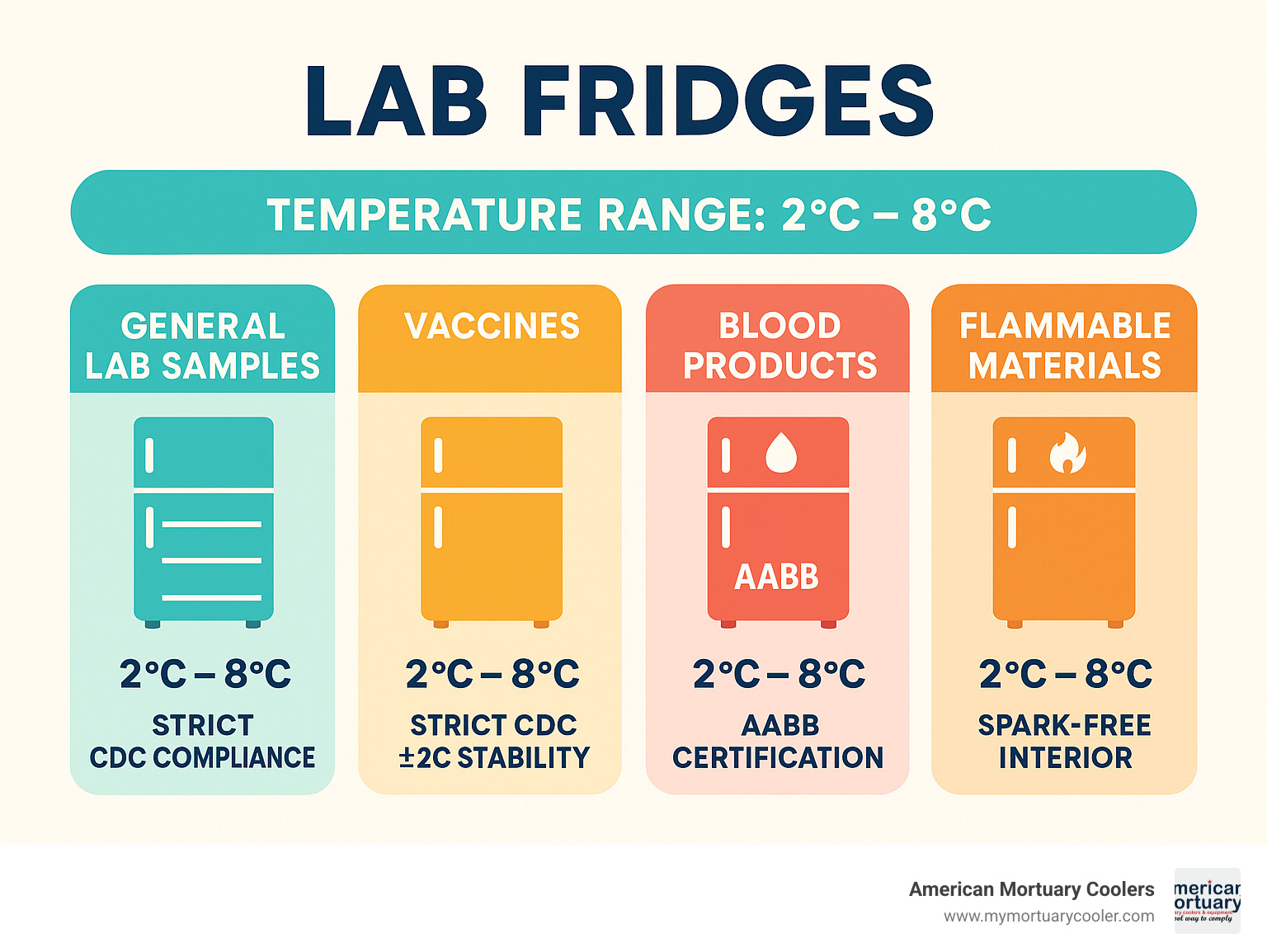
Lab fridges vocab to learn:
What Makes Lab Fridges Different from Domestic Refrigerators?
When you open a lab fridge versus your kitchen refrigerator, you might not notice much difference at first glance. But under the hood, these units are engineered for completely different missions—and that difference can save or destroy thousands of dollars worth of critical samples.
Lab fridges are purpose-built with microprocessor control systems that domestic refrigerators simply don't have. While your home fridge might swing 5-10 degrees without you noticing, a laboratory refrigerator maintains rock-steady temperatures through fan-forced circulation that eliminates those dangerous hot and cold spots.
The industrial insulation in lab fridges is another game-changer. We're talking about specialized materials that keep temperatures stable even when someone leaves the door open a bit too long during sample retrieval. Many of these units also carry ENERGY STAR® certification, proving they can deliver precision without breaking your energy budget.
Precise 2°C–8°C Zones: The Heart of Lab Fridges
Here's where lab fridges really shine: temperature uniformity within ±2°C across the entire storage space. That might sound like a small detail, but it's the difference between vaccines that work and vaccines that don't.
The secret lies in advanced sensor networks that monitor multiple points inside the chamber. These sensors work with fan-forced circulation systems to eliminate temperature stratification—those invisible layers of warmer and cooler air that plague regular refrigerators.
Most lab fridges also include probe ports for external temperature monitoring. This means you can verify actual sample temperatures without opening the door and disrupting the environment.
Scientific research on temperature uniformity shows that OptiCool™ technology combines variable capacity compressors with natural hydrocarbons to deliver optimal temperature performance while reducing energy consumption—something you'll never find in a domestic unit.
Why Domestic Units Fail Critical Storage
Let's be honest about why domestic refrigerators are disasters waiting to happen in laboratory settings. Those convenient frost-free cycles that keep your home fridge ice-free? They create massive temperature swings that can destroy temperature-sensitive materials in minutes.
The CDC has issued clear warnings against using domestic refrigerators for vaccine storage, and for good reason. Door racks expose materials to ambient temperature fluctuations, while poor air circulation creates unpredictable hot and cold zones throughout the storage space.
We've seen facilities learn this lesson the expensive way. One research lab lost an entire batch of enzyme stocks worth $25,000 when their "temporary" dorm-style fridge couldn't maintain stable temperatures during a heat wave. The lack of monitoring in domestic units means problems go undetected until it's too late.
Types of Lab Fridges & Their Specific Applications
Choosing the right lab fridges isn't just about temperature—it's about matching your specific storage needs with the right engineering features. Get this wrong, and you could face regulatory violations, sample loss, or worse.
Let's start with general-purpose lab fridges, the workhorses of most laboratories. These units handle your everyday storage needs like reagents, culture media, and routine samples. With capacities ranging from compact 1.8 cubic feet up to spacious 72 cubic feet, they offer reliable temperature control with straightforward digital displays.
Pharmacy and vaccine refrigerators take things up a notch. These units meet strict CDC and VFC guidelines with improved temperature stability and comprehensive data logging. You'll find lockable doors to protect valuable medications and sophisticated alarm systems that alert you the moment something goes wrong.
When it comes to blood bank refrigerators, precision is everything. These specialized units comply with AABB standards and feature temperature mapping that ensures uniform conditions throughout every corner of the storage chamber. The shelving systems are designed specifically for blood component storage—no guesswork involved.
Safety becomes the priority with flammable storage refrigerators. These units feature spark-free interiors and sealed electrical components, allowing you to safely store volatile chemicals and solvents while meeting NFPA and OSHA standards.
Explosion-proof models represent the ultimate in hazardous environment storage. These sealed systems are engineered for locations where explosive vapors might be present—think advanced chemistry labs or industrial facilities.
Don't forget about specialty options like chromatography refrigerators for analytical work, dual-temperature combo units that offer both refrigeration and freezing, and even morgue specification units for specialized applications.
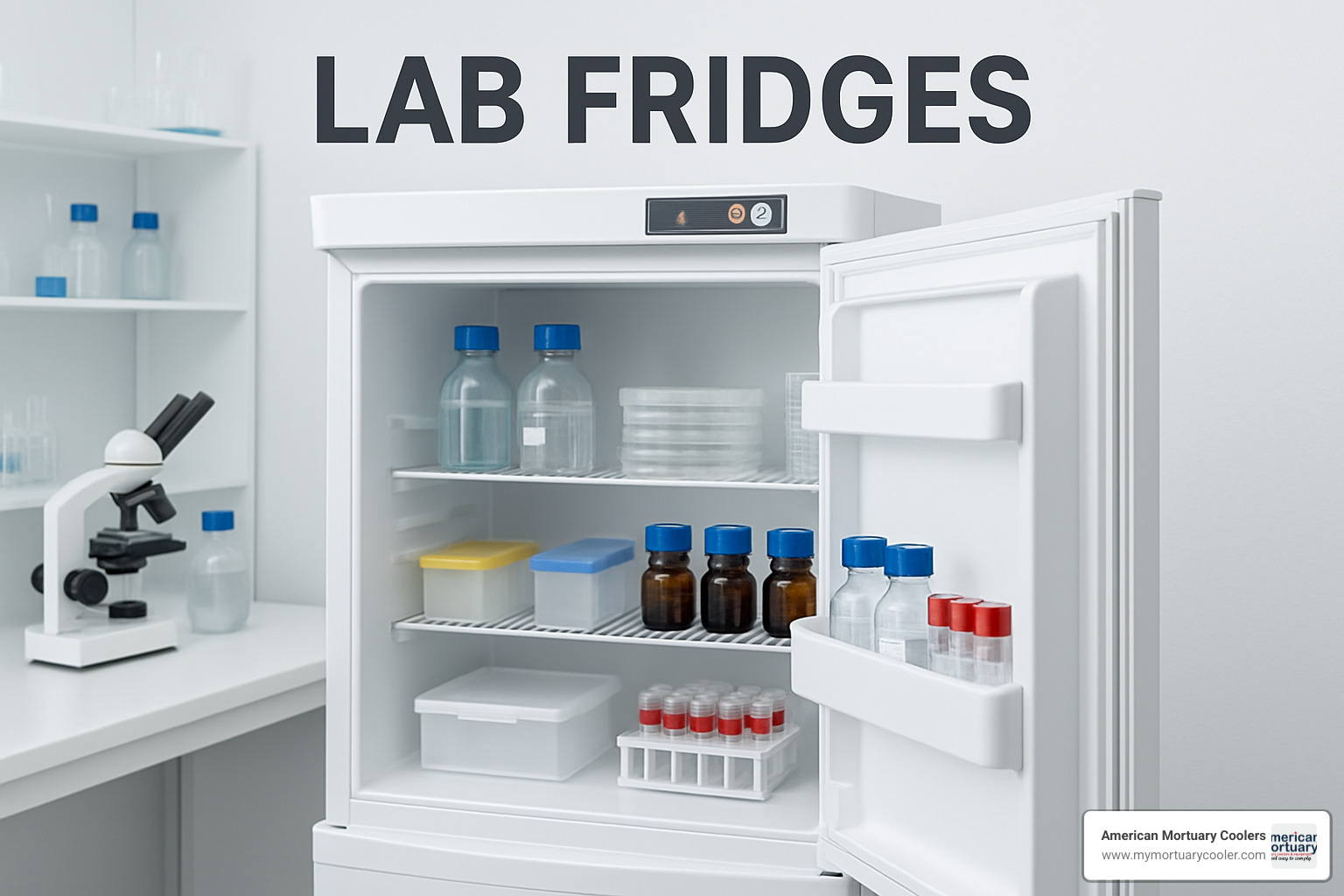
Lab Fridges vs. Lab Freezers: Choosing the Right Chamber
The temperature difference between lab fridges and lab freezers isn't just numbers—it determines what stays viable and what gets destroyed. Lab fridges maintain that critical 2°C–8°C range, while lab freezers operate at much colder temperatures from -20°C down to -80°C.
Your lab fridges excel at storing active enzyme solutions that would lose activity if frozen, cell culture media that needs to stay liquid, vaccines and medications following CDC guidelines, and short-term biological samples for immediate use. They're also perfect for chemical reagents that remain stable at refrigerated temperatures.
Lab freezers handle the long-term storage needs: enzyme stocks for future use, tissue archives that need preservation, DNA and RNA samples requiring ultra-cold conditions, and frozen cell lines for research continuity.
Some facilities choose dual-temperature combo units with independent compressor systems. These clever designs give you both refrigeration and freezing in one footprint—typically around 400 liters of refrigerated space paired with 400 liters of freezer capacity.
Specialty Blood Bank & Vaccine Lab Fridges
Blood bank applications demand AABB compliance with features you won't find on standard units. Glass doors let you check inventory without opening the unit and exposing contents to temperature swings. Solid doors provide maximum thermal retention when visibility isn't crucial.
Lockable drawers keep samples organized and secure, while redundant alarm systems with remote notification ensure you're alerted immediately if something goes wrong—even when you're off-site.
Vaccine storage follows CDC-compliant specifications including self-closing doors with 90-degree stops that can handle heavy loads without staying open. Continuous data logging with min/max temperature recording provides the documentation required for regulatory compliance.
Flammable & Explosion-Proof Models for Solvents
Storing volatile chemicals isn't just about temperature—it's about preventing disasters. Flammable storage lab fridges feature spark-free interiors where every electrical component is sealed away from the storage chamber. Explosion-proof construction takes this further for truly hazardous environments.
These units meet NFPA and OSHA standards because they have to—there's no room for shortcuts when dealing with volatile materials. Specialized ventilation systems prevent vapor accumulation that could lead to dangerous situations.
| Feature | General Purpose | Vaccine Storage | Blood Bank | Flammable Storage |
|---|---|---|---|---|
| Temperature Range | 2°C–8°C | 2°C–8°C | 1°C–6°C | 2°C–8°C |
| Stability | ±3°C | ±2°C | ±1°C | ±2°C |
| Compliance | Basic | CDC/VFC | AABB | NFPA/OSHA |
| Alarms | Basic | Improved | Redundant | Explosion-proof |
| Capacity Range | 1.8–72 cu.ft. | 5.5–51.1 cu.ft. | 12–49 cu.ft. | 5.5–50 cu.ft. |
For more detailed information about specialized storage solutions, check out our guide on Specimen Refrigerators Explained: Chill Out, Your Samples Are Safe.
Performance, Monitoring & Security Features That Matter
When you invest in lab fridges, you expect them to guard samples around the clock. The real difference between entry-level and premium models is how tightly they hold temperature and how quickly they alert you to trouble.
Temperature stability comes first. Quality units stay within ±2 °C thanks to variable-speed compressors that recover quickly after every door opening.
Modern electronics add another safety layer. Data loggers store thousands of time-stamped readings for painless audits, while ENERGY STAR® designs that use natural refrigerants such as R290 and R600a deliver this precision with far less energy.
Security is equally important. Keyed locks, digital access logs, and even antimicrobial handles reduce both unauthorized entry and contamination.
Continuous Temperature Monitoring for Lab Fridges
Forget twice-daily manual checks. Digital recorders with NIST-traceable calibration track the chamber every minute, producing a complete audit trail. With SMART VUE Wi-Fi you receive instant alerts on any computer or phone, so weekend surprises disappear. Min/max graphs let you correct small trends before they threaten inventory. For the science behind it all, see our guide on Refrigeration System 101: Understanding the Basics.
Advanced Add-Ons: Remote Dashboards & Touchscreens
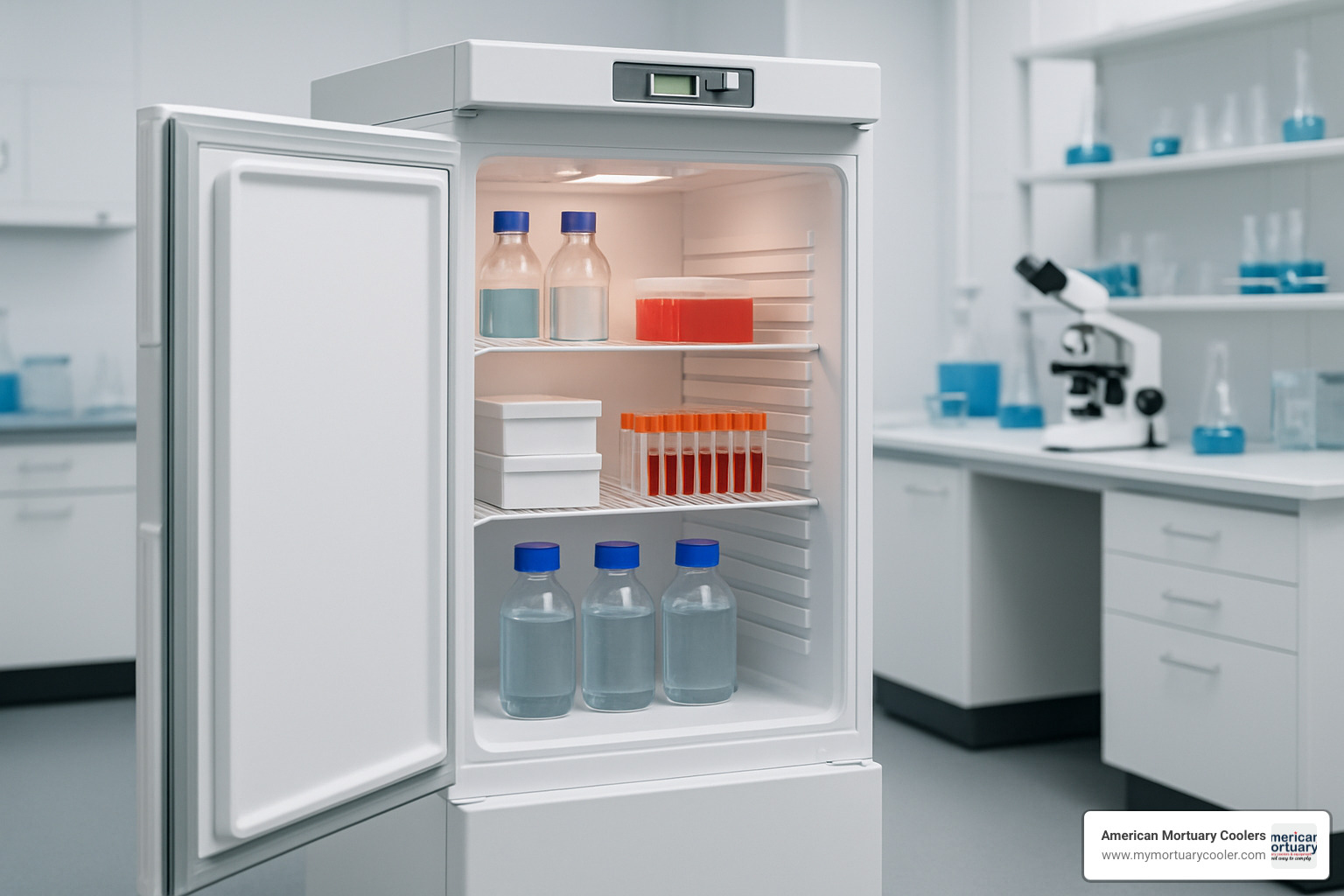
Touchscreen controllers put temperature, alarm status, and diagnostics on one bright display. Wi-Fi modules push data straight to your LIMS, eliminating manual logs, while GSM text alerts keep staff informed after hours.
Selecting, Installing & Maintaining Your Lab Fridge
Treat the buying process like any capital purchase: match capacity, footprint, and compliance to your workflow.
Sizing starts with the 30 – 80 % loading rule. Too small and airflow is blocked; too large and you pay to cool empty space. Most labs do well when current needs fill about 40 % of the chamber, leaving room for growth.
Installation matters. Leave at least 6 inches of clearance for freestanding condensers, and keep units away from heat sources or direct sunlight. Built-in models need properly vented cabinetry, not a tight closet.
Once running, quarterly preventive maintenance—coil cleaning, gasket inspection, alarm checks—avoids costly downtime. Schedule annual ISO 17025 calibration during slow periods and keep certificates on file for auditors.
Step-by-Step Buying Checklist for Lab Fridges
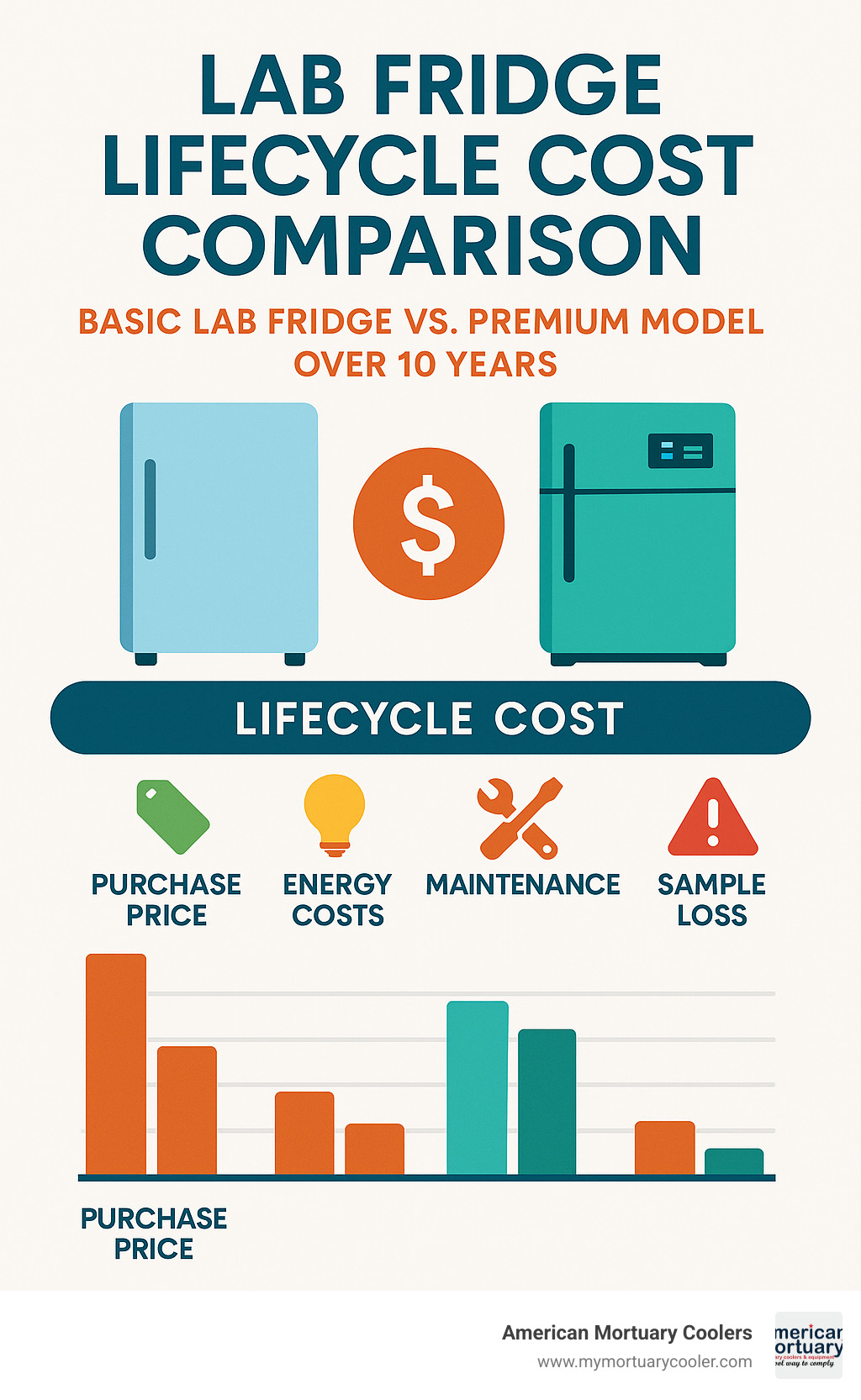
- Use a capacity calculator, then add roughly 25 % for expansion.
- Map mandatory regulations (CDC, AABB, NFPA) so you only pay for features you truly need.
- Compare total cost of ownership, not just sticker price—energy and sample loss dwarf initial savings.
- Verify warranty length and local service coverage; a five-year warranty is useless if help is two weeks away.
Routine Maintenance & Calibration Best Practices
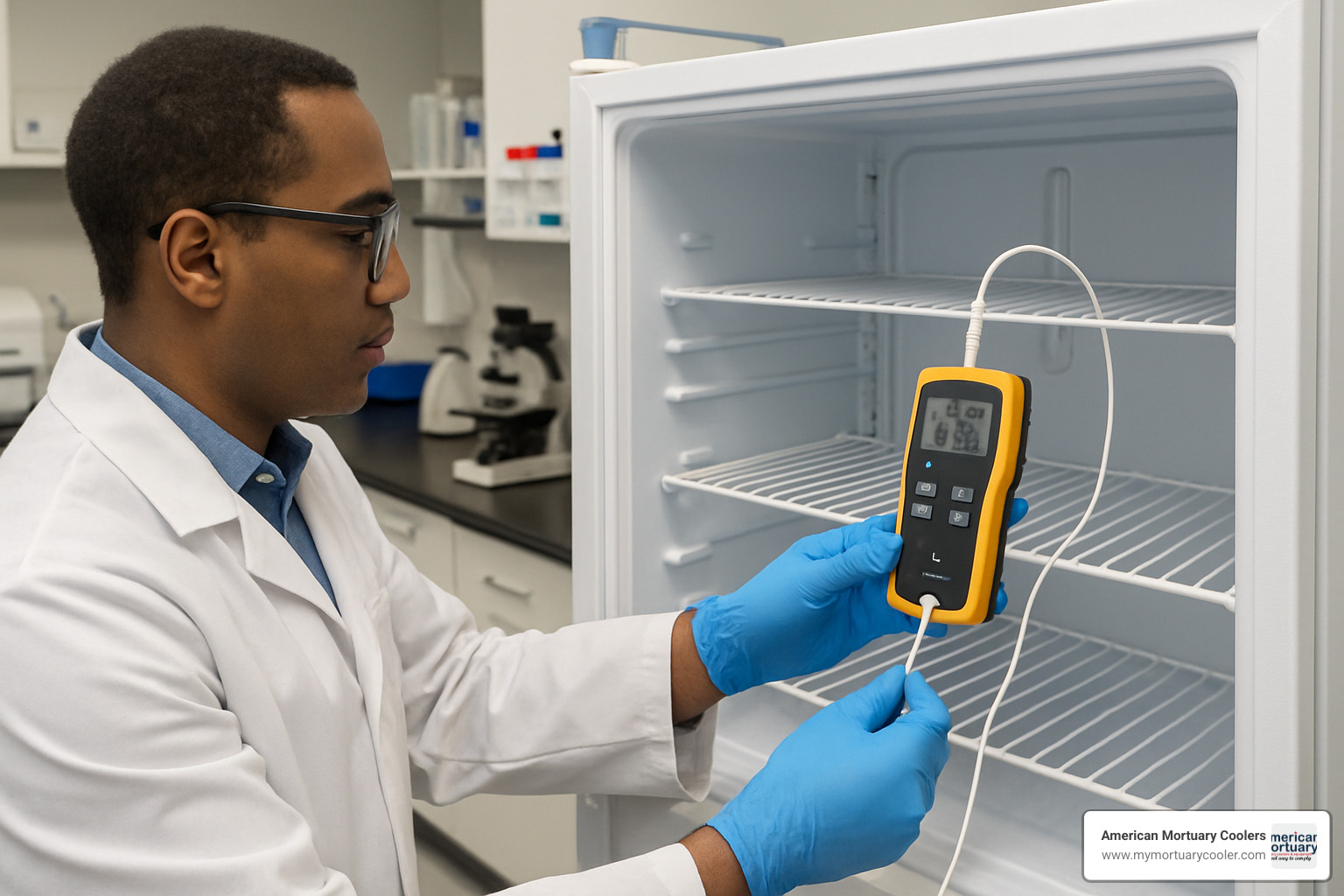
Use NIST-traceable thermometers and document calibrations annually. Break service into quarterly (visual, coils, gaskets), semi-annual (fans, electrical), and annual (full system and temperature mapping) tasks. A consistent plan costs little and safeguards everything inside.
Regulatory & Sustainability Considerations for Lab Fridges
When you're shopping for lab fridges, the alphabet soup of regulations can feel overwhelming. But here's the thing—each standard exists for a good reason, and understanding them helps you choose equipment that won't leave you scrambling during your next audit.
The CDC takes vaccine storage seriously, and for good reason. Their guidelines mandate specific temperature ranges and continuous monitoring because even small temperature excursions can destroy thousands of dollars worth of vaccines. They're particularly strict about banning combination refrigerator-freezers after too many facilities learned expensive lessons about temperature fluctuations.
VFC (Vaccines for Children) program requirements go even further, adding security measures and inventory tracking that protect these publicly-funded vaccines. If you're storing VFC vaccines, your lab fridges need lockable doors and detailed access logs.
For medical applications, FDA registration becomes important. Take FDA Registration Number 3018799069 for the Accucold Division—this registration covers medical device refrigerators used in clinical settings.
ISO standards cover different aspects of lab refrigeration. ISO 9001:2015 ensures manufacturers have quality management systems in place, while ISO 17025 applies to the calibration labs that validate your temperature readings for regulatory compliance.
Blood banks face their own set of rules. AABB standards govern everything from temperature uniformity to alarm systems, ensuring blood products remain safe for transfusion.
Working with flammable materials? NFPA and OSHA standards aren't suggestions—they're requirements. These regulations mandate spark-free construction and explosion-proof electrical components that prevent dangerous incidents.
Meeting ENERGY STAR® and Green-Lab Goals

The introduction of ENERGY STAR® specifications for lab fridges is a game-changer for laboratory sustainability. Laboratories are notoriously energy-hungry, and cold storage equipment often runs 24/7, making efficiency improvements particularly valuable.
OptiCool™ variable compressors represent the kind of smart technology that makes a real difference. Instead of running at full capacity all the time, these systems adjust their cooling output based on actual demand. The result? Energy savings of 30-40% compared to older fixed-capacity systems.
Low-GWP refrigerants like R290 (propane) and R600a (isobutane) are becoming the new standard. These natural hydrocarbons have Global Warming Potentials under 3, compared to over 1,400 for traditional HFC refrigerants. They also happen to be excellent at moving heat, so you get better performance with less environmental impact.
ACT (Appliance Certification and Testing) labels take the guesswork out of energy comparisons. These standardized labels show exactly how much energy different models consume, helping you calculate real-world operating costs over the equipment's lifetime.
The bottom line? Today's lab fridges can meet strict regulatory requirements while reducing both your energy bills and environmental footprint. It's a win-win that makes compliance officers and sustainability managers equally happy.
Frequently Asked Questions About Lab Fridges
Let's tackle the most common questions we get about lab fridges. After years of helping facilities choose the right cold storage solutions, these are the concerns that keep coming up.
What temperature ranges are required for vaccines, blood, reagents, and samples?
Getting the temperature right isn't just important—it's everything when it comes to preserving your valuable materials.
Vaccines need precise care between 2°C and 8°C with rock-solid stability within ±2°C of your set point. The CDC doesn't mess around here—they recommend that advanced medical refrigerators keep temperature swings no higher than 2°C outside the thermostat setting. One degree too high or too low, and you're looking at compromised vaccine potency.
Blood products follow AABB standards requiring storage between 1°C and 6°C. Different blood components have their own specific sweet spots within this range, so your lab fridge needs to maintain consistent conditions throughout the entire chamber.
Chemical reagents and enzymes generally do well at the standard 2°C–8°C range for day-to-day use. However, some enzymes are picky and need freezer storage at -20°C for long-term stability—know your reagents before you store them.
Biological samples are where things get interesting. Cell cultures prefer 4°C for short-term storage, while DNA and RNA samples need the deep freeze at -20°C to -80°C for long-term preservation. Proteins can go either way—some are happy at 2°C–8°C, others need to be frozen depending on their stability profile.
How do I size a lab fridge for future growth without overspending on energy?
This is the million-dollar question, and we've got a practical approach that works.
Start by calculating your current storage volume—and we mean everything, including all those bulky containers and packaging materials that eat up space. Then add 25% for growth over the next 3-5 years. This gives you breathing room without going overboard.
Here's the sweet spot: size your unit so current needs represent about 40% of total capacity. This keeps you in that optimal 30%–80% loading range we talked about earlier, with room to grow.
Choose ENERGY STAR® certified models to keep energy costs in check. These units are designed to operate efficiently even when not fully loaded, which matters more than you might think.
Consider modular solutions if you're expecting significant growth. Sometimes two smaller units make more sense than one oversized refrigerator that's going to waste energy running half-empty for years.
Lab fridges work best when properly loaded. An oversized unit running at 15% capacity is like heating a mansion when you only live in one room—it wastes energy and struggles with temperature uniformity.
What alarms and data logs are mandatory for audit compliance?
Nobody wants to face an audit unprepared, so let's break down what you actually need.
Your alarm system needs to cover the basics: high and low temperature alerts (both audible and visual), power failure notifications, and door ajar warnings after 30-60 seconds. Most importantly, you need remote notification capability for after-hours monitoring—because samples don't take weekends off.
Data logging requirements depend on what you're storing. CDC and VFC programs require continuous temperature monitoring with data stored for at least three years. AABB blood banks need temperature recordings every four hours minimum, though continuous monitoring is preferred. Research applications often demand 24/7 data logging with readings every minute.
Your documentation must include temperature readings with timestamps, alarm events and how you responded, calibration certificates for all monitoring equipment, and maintenance records with any corrective actions taken.
The good news? Modern lab fridges typically include built-in data loggers that store thousands of readings and can export data directly for regulatory submissions. No more manual chart reading or lost paperwork—the technology handles the heavy lifting while you focus on your research.
Conclusion
Choosing the right lab fridges isn't just about picking the biggest unit or the cheapest price tag. It's about finding that perfect balance between keeping your samples safe, meeting regulations, and not breaking the bank on energy costs. The good news? Modern laboratory refrigeration has come a long way, and the right choice will serve you well for years to come.
At American Mortuary Coolers, we've seen how critical temperature control is for preserving everything from vaccines to biological specimens. Our experience delivering custom cold-storage solutions across Tennessee, Atlanta, Chicago, and throughout the contiguous 48 states has taught us that every facility has unique needs—but the fundamentals remain the same.
The precision temperature control we've discussed, proper sizing for your space, staying compliant with regulations, and keeping up with maintenance all work together like a well-oiled machine. When one piece fails, everything else suffers. But when it all works together? Your samples stay safe, your audits go smoothly, and your energy bills stay reasonable.
Today's lab fridges are impressive pieces of technology. ENERGY STAR® certification means they won't drain your budget through electricity costs. Advanced monitoring systems give you peace of mind with real-time alerts and detailed data logs. Sustainable refrigerants like R290 and R600a help you meet environmental goals without sacrificing performance.
Whether you're storing routine reagents in a general-purpose unit, protecting vaccines in a CDC-compliant refrigerator, or handling specialized applications that require custom solutions, the principles we've covered will guide you to the right choice. 30%–80% loading sweet spot, plan for growth without oversizing, and invest in proper monitoring and maintenance.
The truth is, lab fridges do more than just keep things cold—they protect the work that advances medical research, ensures vaccine efficacy, and supports the vital work happening in laboratories nationwide. When you choose quality equipment and maintain it properly, you're investing in reliability that lets you focus on what matters most: your important work.
For facilities dealing with specialized storage needs, including mortuary applications, our comprehensive guide on The Complete Guide to Body Fridges and Mortuary Refrigerators offers additional insights into temperature-controlled storage solutions.
Your samples deserve better than a converted dorm fridge. They deserve precision, reliability, and the peace of mind that comes with proper laboratory refrigeration. Choose wisely, and your lab fridges will be the quiet heroes protecting your valuable work for many years to come.



